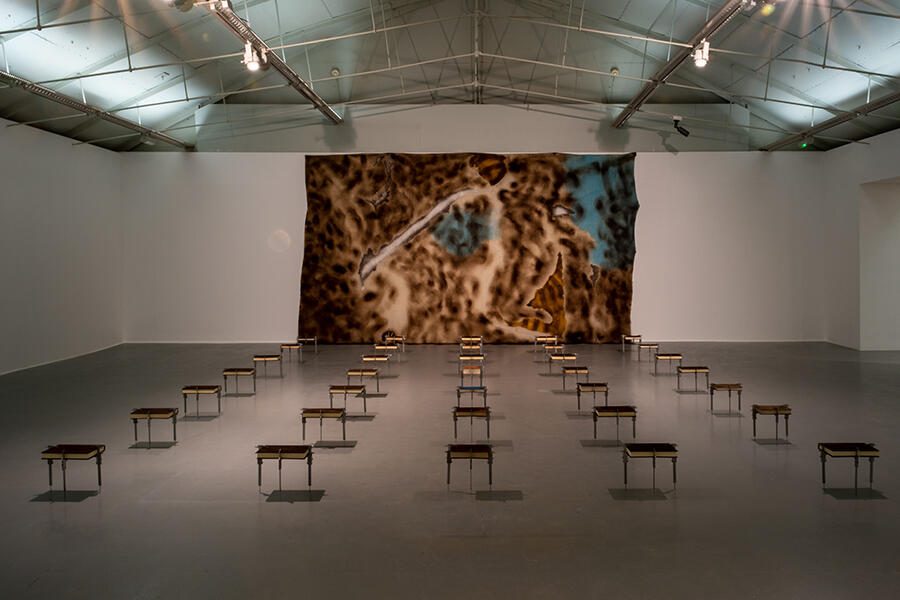Liverpool Biennial Seeks to Heal the City’s Past
Khanyisile Mbongwa’s programme addresses the history of international slave trading that haunts its famous docks
Khanyisile Mbongwa’s programme addresses the history of international slave trading that haunts its famous docks

This year, Cape Town-based curator Khanyisile Mbongwa’s Liverpool Biennial – titled after the isiZulu term uMoya, which translates loosely as ‘wind’, ‘climate’, ‘breath’ or ‘soul’ – forms a cartography of the city, homing in on the history of international slave trading that haunts its famous docks. In preparation, Mbongwa spent extended periods dockside, feeling the wind on her skin, just as people had done before her – albeit under very different circumstances.
‘uMoya: The Sacred Return of Lost Things’ contains works by 35 artists, many based in or descend from the Global South, that eschew traditional European painting for performance, video art, film and installation. As Mbongwa outlined during the press conference, preventing participating spaces’ institutional concerns from overriding an artist’s integrity was essential to her mission, with works appearing in unexpected places and historic buildings as well as in more conventional gallery contexts.

Inside the Tobacco Warehouse – the world’s largest brick-built warehouse, quayside at Stanley Dock – Julien Creuzet’s multimedia sculpture The Possessed of Pigalle or the Tragedy of King Christophe (2023) is suspended from the ceiling. Electrical wire and ribbon – taut as if wrapped around flesh – weave across the works to create an at-once earthly and starkly artificial assemblage. The eclectic style pays homage to creolisation, a cultural process that informs the artist’s Martinican origins.
In an adjacent hangar, Albert Ibokwe Khoza performed The Black Circus of the Republic of Bantu (2022), inviting a majority-white audience to watch as, with wrists bound, they memorialized the victims of historical human zoos. Khoza’s incantations rose to a crescendo, their eyes rolling back and their cowry-shell earrings swinging. Pausing, the artist then summoned four white guests to enrobe themselves in monkey masks and bibs. ‘Dance!’ bellowed Khoza, cracking a whip and demanding the audience to cheer. Eyes flickered with indecision: better to engage in colonial cosplay or sit in silence? A strangled ‘hooray’ was mustered, but Khoza’s implicating gaze reversal was impossible to avoid.

Subtler but just as perturbing is Francis Offman’s exacting, two-part installation at Tate Liverpool, featuring an abstract wall hanging and a floor-based arrangement (Untitled, 2019–23). A stone’s throw from the Albert Dock, Offman creates the suggestion of human bodies by mottling draped fabric with paint and coffee grounds in a reference to his native Rwanda – one of the world’s major coffee exporters. Below the drape is a formation of books, each held up by a set of callipers: the tool used by Belgian colonizers to measure and segregate Rwandans based on facial dimensions. A century later, during the Rwandan Genocide of 1994, it was these imposed ethnic divisions that led Hutu militias to massacre the minority Tutsi. A bible owned by Offman’s mother, carried with her as she fled Rwanda at this time, stands at the centre of the installation – a harrowing witnesses to the atrocities.

At times, however, Mbongwa’s curatorial conceit misses its mark. Despite being an excellent film, Melanie Manchot’s STEPHEN (2023), for instance – which focuses on mostly white people in the recovery community – felt like a subplot to Mbongwa’s main curatorial focus on the responses of Black, Indigenous and POC artists to European imperialism. Asked at the press conference whether she had visited Liverpool’s outskirts – where one of Europe’s oldest Black communities exists – Mbongwa squirmed, suggesting it would be a ‘violence’. The response didn’t add up: the biennial covers work from myriad nations and professes a situated response to Liverpool. Such footnotes aside, however, she makes a powerful case: Liverpool is only a British centre for culture today because it was once the British centre of slavery.
‘uMoya: The Sacred Return of Lost Things’ is on view at various locations in Liverpool, UK until 17 September
Main image: Tobacco Warehouse exterior, undated. Courtesy: Liverpool Biennial
























